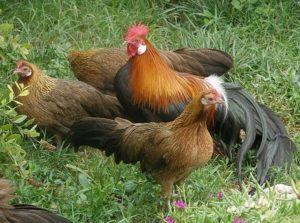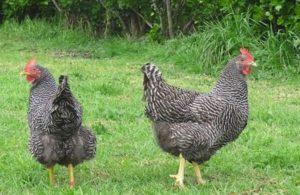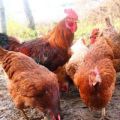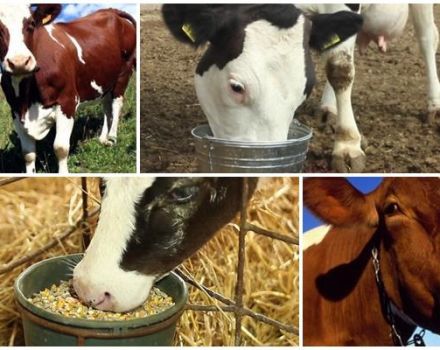Description and characteristics of chickens of the Brown Nick breed, features of the content
Chickens of the Brown Nick breed are known for their high egg production rates. If the content rules are followed, they begin to rush at 4 months of age. They give from 350 to 400 eggs per year, which have excellent taste. The bird is unassuming to care for, has good immunity. Suitable for growing in any region of Russia. The character of the champion laying hen is meek, docile.
Origin story
The brownnik breed was recorded in 1965. It took the geneticists of the German corporation "H & N International" 10 years to get chickens with high productivity rates, immune to the main diseases of birds.
Description and main characteristics of the brown nick breed
Crosses practically do not stand out against the background of other egg breeds. The appearance of birds depends on gender. You can distinguish young animals immediately after birth. This makes it possible to cull males.
External signs of thoroughbred roosters and hens
Brown roosters look like this:
- powerful, atypical physique;
- the skin is light;
- snow-white plumage color;
- medium-sized leafy crest;
- slightly bent beak;
- four-toed matte yellow legs.

The chickens have the same massive constitution, the color of the feathers is copper-red. A ridge of a similar configuration, smaller.
Cross productivity
German geneticists are proud of the achieved indicators: early egg-laying of Brownnik chickens and year-round productivity. In addition, the survival rate of juveniles and adults is 96 to 98%.
Egg
Chickens reach sexual maturity at the age of 20-23 weeks. Up to 8 months, the egg weight is 45-50 g, then gradually grows to 70 g. The shell is strong, dark brown in color. Egg production rates begin to decline from 18 months. For 1 calendar year, the hybrid produces from 350 to 400 eggs.
Meat
The weight of the males is from two and a half to 3 kg. Layers weigh much less - from 1.6 to 2 kg.
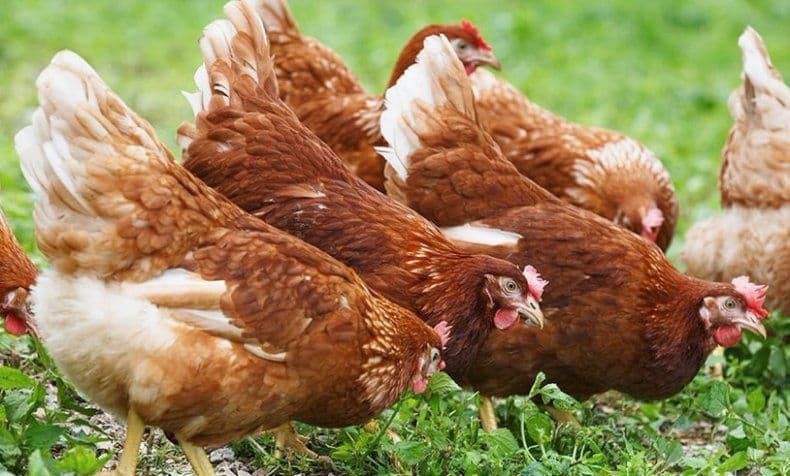
Character traits
Chickens of the Brown Nick breed have a calm restrained character. Even an inexperienced beginner can cope with them. Roosters are not at enmity with each other, they are not afraid of the owner.
Advantages and disadvantages
The pluses of the breed include:
- year-round egg production;
- unpretentious content;
- the livable disposition of the bird;
- the egg is large, the shell is dense;
- the survival rate of chicks is 98%;
- small feed consumption per 1 individual.
The disadvantages of the breed include heat intolerance, as well as a complete loss of the hatching instinct. To obtain young animals, you have to use an incubator.
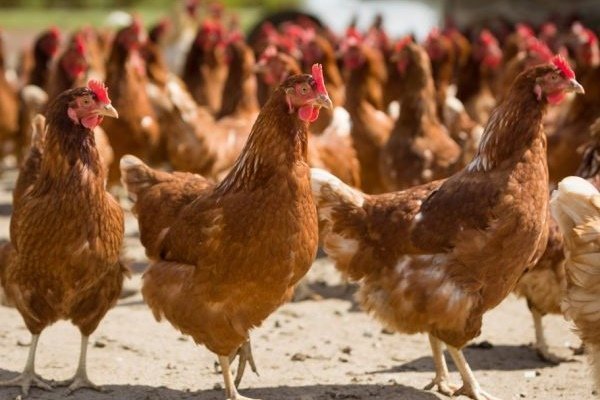
The nuances of caring for a hybrid
If brown chickens are not properly cared for, their productivity will decline. When properly kept (a bird can live in cages or in a chicken coop), they show high egg production.
Premises
Before settling in the flock, the poultry house is washed and disinfected. The birds are vaccinated. There should be no drafts in the room, it is necessary to close access to the chicken coop for other domestic animals and rodents.
The main condition for breeding hybrids is dryness, warmth, cleanliness in the chicken coop. Average temperature in summer: + 21 ... + 27 ˚С. During the cold season, the temperature inside the house should not fall below +5 ˚С. The optimum moisture content is 75%.
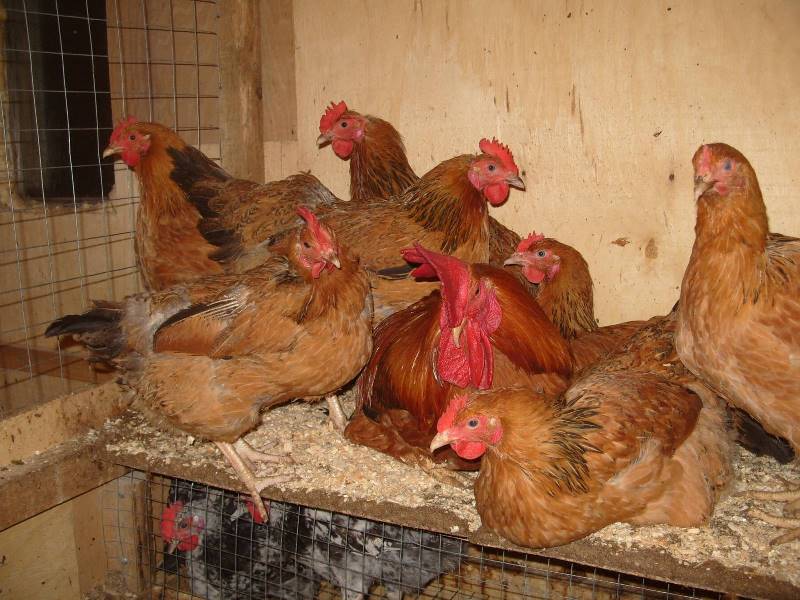
Light mode
During the period of increased egg-laying, daylight hours are gradually increased to 15-16 hours, adding 30 minutes daily. The minimum indicator of light intensity is 10-12 Lux.
Place for walking
Brown nik crosses do not tolerate strong winds and drafts. Walking places for them are equipped on the leeward, not shady side. The space is surrounded by a net, the height of which is at least 2 m.
Important! In winter, it is better not to let chickens out of the poultry house. The bird may catch a cold or freeze the comb.
Molting and decreased egg production
The change of plumage in Brownnik crosses occurs in winter and lasts for several months. To speed up the process, breeders stimulate with special medications or shorten daylight hours. During molting, the egg production of the hybrid decreases.

Diet
Brown nickname crosses are unassuming in food. In agro-industrial complexes, chickens are fed with concentrated feed and compound feed. The diet of poultry, which is kept in private farmsteads, includes wet mash, sprouted grain, food waste.
Feeding hens
The bird is fed three times a day. An adult chicken consumes 100-110 g per day. The approximate diet of the record holders is:
- cereals in germinated or dry form;
- greens (in summer - grass, in winter - chopped needles);
- sunflower seeds;
- a mash with the addition of boiled vegetables;
- vitamin supplements.
In the morning, the chickens are given a mash, at lunch they are given sprouted wheat or steamed grain, in the evening - dry grain. Drinking water should always be kept fresh. In hot weather, it is changed several times a day.

Mash preparation
To prepare the mash, use broth, reverse, boiled water. They add to it:
- meat and bone or fish meal;
- fruits;
- herbal flour or fresh herbs;
- vitamin and mineral supplements.
To increase productivity, the mash is supplemented with meat and fish products, maggots and earthworms.
Vegetables
Brownik crosses are energetic, therefore they need a large amount of biologically active substances. Vegetables and herbs to provide vitamins for chickens of this breed:
- tops of grass;
- nettle;
- chopped carrots or beets.

Mineral supplements are also mixed into the feed.
Waste
In addition to vitamin complexes, the hybrid needs protein and calcium. Insufficient consumption of trace elements leads to a decrease in egg production rates, and the shell becomes fragile. It is possible to provide chickens of the Brown Nick breed with calcium by introducing fermented milk products into the diet. You can add grated shells to the feed.
Caution! You need to grind the shell very carefully, into powder. Otherwise, the hens will begin to peck at the eggs.
Breeding subtleties
Chickens brown nick - autosex cross. Immediately after birth, the sex of the chicks can be determined. In future hens, a light strip of fluff stands out on the back. The color of chickens is darker than that of males.This makes it possible to separate them in order to create appropriate housing conditions for each group, since the diet of young males and hens is different.
Feeding scheme for young animals:
- from 0 to 21 days, young animals are fed every 2 hours;
- from 22 to 45 days - 5 times a day;
- from 46 days they switch to 3 meals a day.
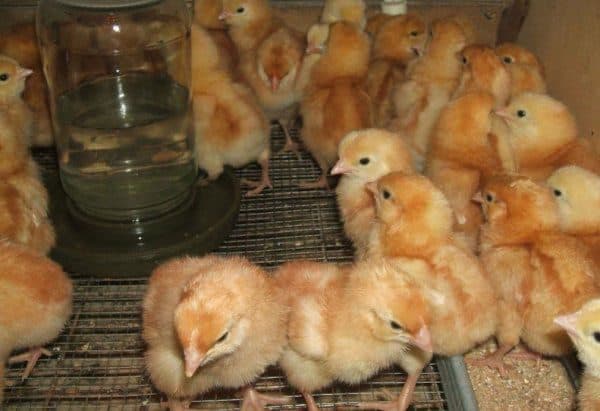
Diet of chicks by day:
- 1-3 - newborns are fed with corn, semolina, barley;
- from 3 - calcium is introduced (for 10 chicks - 50 g of cottage cheese);
- from 30 - processed grain is added to the main diet;
- from 35 - add chopped grass (nettles, dandelions, green onion feathers);
- from 40 - young animals are transferred to adult hens feed.
Chicks should be provided with fresh, clean water. With a lack of fluid, the growth and development of chicks slows down.
Signs indicating shortcomings in the maintenance of young animals:
- apathetic, lethargic chickens - hot in the hen house;
- squeak loudly, huddled in a heap - they are cold, they are hungry;
- the litter is viscous to the touch, sticky - violation of the temperature regime.
Brown chickens, like their parents, are picky about food. The main thing is to control the amount of food so that the chicks do not overeat, as this is fraught with indigestion and obesity.

Diseases and prevention from them
Clusters rush almost all year round, they are prone to typical chicken diseases, so attention should be paid to their health.
Cross diseases:
- deviations in the development of the oviduct;
- rickets;
- lack of vitamins.
To prevent the development of the disease, the poultry house is kept clean, the chickens are provided with the optimal temperature regime, and the necessary vitamins are provided. In addition, the bird is vaccinated in a timely manner:
- newborn chicks - from Marek's disease;
- in the period from 14 to 30 days - from bursitis and infectious bronchitis;
- from 60 to 90 days - from encephalomyelitis, smallpox, bronchitis, Newcastle disease.
The maximum performance indicators of record holders fall on the first 3 years of life, then it is advisable to replace the herd.
Due to the high egg production, excellent taste of the product, brownik chickens occupy the first positions in the list of favorite breeds of poultry breeders.
